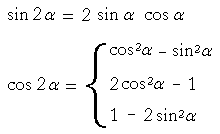
Proof of the double-angle and half-angle formulas
Double-angle formulas

Proof
The double-angle formulas are proved from the sum formulas by putting β = ![]() . We have
. We have
| sin 2 |
= | sin |
| = | 2 sin |
|
| cos 2 |
= | cos |
| cos 2 |
= | cos² |
This is the first of the three versions of cos 2![]() . To derive the second version, in line (1) use this Pythagorean identity:
. To derive the second version, in line (1) use this Pythagorean identity:
sin²![]() = 1 − cos²
= 1 − cos²![]() .
.
Line (1) then becomes
To derive the third version, in line (1) use this Pythagorean identity:
cos²![]() = 1 − sin²
= 1 − sin²![]() .
.
We have
| cos 2 |
= | 1 − sin² |
| cos 2 |
= | 1 − 2 sin² |
These are the three forms of cos 2![]() .
.
Half−angle formulas
![]() . . . . . . . (2')
. . . . . . . (2')
![]() . . . . . . . (3')
. . . . . . . (3')
Whether we call the variable θ or ![]() does not matter. What matters is the form.
does not matter. What matters is the form.
Proof
Angle ![]() is half of the angle 2
is half of the angle 2![]() . Therefore, in line (2), if we
. Therefore, in line (2), if we
| put 2 |
θ 2 |
: |
| cos θ | = | 2 cos² | θ |
− 1. |
| On solving this for cos | θ |
, we will have the half-angle formula for the |
cosine.
So, on exchanging sides and transposing 1, we have
| 2 cos² | θ | = | 1 + cos θ |
| cos² | θ | = | ½(1 + cos θ) |
| cos | θ | = | |
This is the half-angle formula for the cosine. The sign ± will depend on the quadrant. Again, whether we call the argument θ or ![]() does not matter.
does not matter.
Notice that this formula is labeled (2') -- "2-prime"; this is to remind us that we derived it from formula (2).
| The formula for sin | θ |
comes from putting 2 |
transposing, line (3) becomes
| 2 sin² | θ |
= | 1 − cos θ, | |
| so that | ||||
| sin | θ |
= | ||
This is the half−angle formula for the sine.
Please make a donation to keep TheMathPage online.
Even $1 will help.
Copyright © 2001-2007 Lawrence Spector
Questions or comments?
E-mail: themathpage@nyc.rr.com